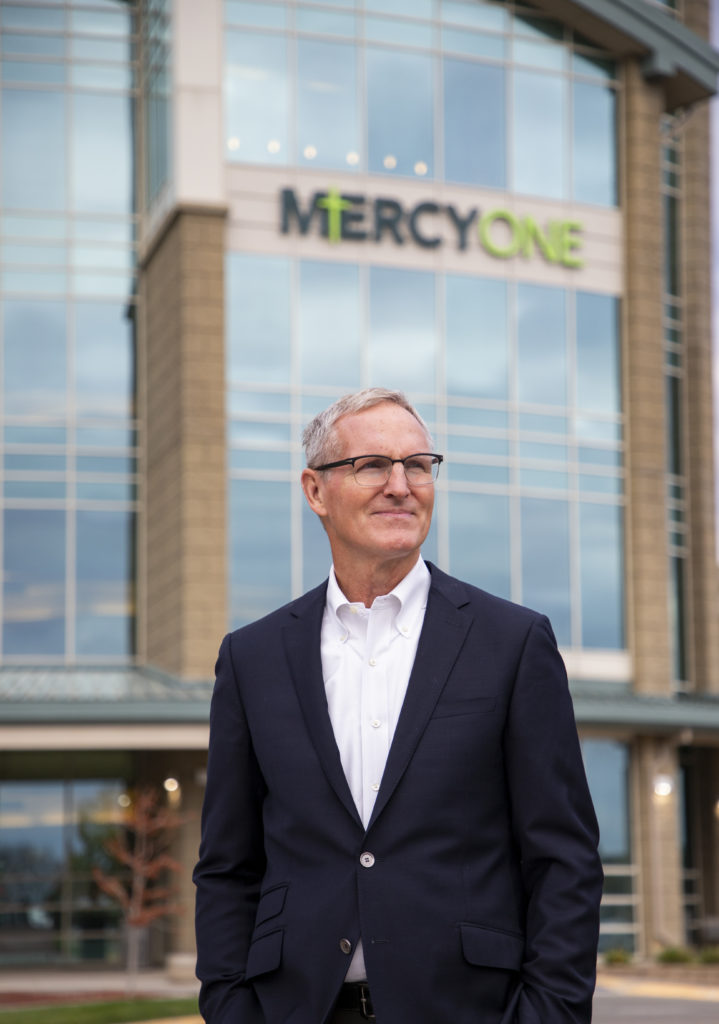By Emily Barske, Business Record editor
The idea to convert some in-person maternal and fetal medicine clinics to telehealth visits had been percolating for a while. But it was ultimately a blizzard in February that prompted the team at MercyOne Des Moines to put the idea into action.
Dr. Neil Mandsager, who is board-certified in obstetrics-gynecology and maternal-fetal medicine, has been providing maternal-fetal medicine outreach to various Iowa communities since the mid-1990s, specializing in providing support to local care teams for high-risk pregnancies. He consults on cases where the patient might have high blood pressure, diabetes, previous problems with pregnancies or other medical problems, as well as providing fetal surveillance via ultrasounds.
“The first place that I went to was Mason City — and so I’ve been going in person to Mason City, twice a month, and running perinatal outreach clinics for a long time,” Mandsager said. “I’ve also been to Ottumwa for a period of time doing the same thing … once a month. Pella I’ve been doing for quite a while.”
Over the decades, those clinics have often meant lots of traveling for Mandsager and sometimes his patients, too. The travel that was required increased further when one of the MercyOne facilities in Waterloo asked to have an in-person maternal-fetal medicine clinic once a month.
As telehealth emerged as a possibility, it became clear that it could reduce that travel time.
“In February this year we’d been talking about converting some of those in-person clinics to telehealth clinics,” Mandsager said. “And we had a blizzard come up in early February sometime on a day that I was supposed to travel to Waterloo and we made the command decision to start telehealth on that day.”
To do consultations remotely, he has to have the technology for reading ultrasounds as well as the ability to communicate with the patients via videoconferencing.
“Fortunately, we had the IT pieces in place and we were able to do it,” he said. “And so I’ve been doing telehealth in Waterloo ever since. I still go in person once a month, but the other clinics are now telehealth.”
Beyond reducing travel, telehealth also presents a potential solution to another emerging challenge in maternal-fetal medicine by offering better support to birthing centers in smaller communities without requiring their patients to go to large metro areas to obtain care.
Many Iowa communities have lost their birthing centers in the last few decades, in part because more patients have chosen to get services in larger metro clinics where more services — such as those provided by doctors like Mandsager — are available. Being able to do more telehealth consultations means patients can still receive care from doctors in their own communities while they get support from Mandsager via telehealth.
We asked Mandsager to tell us more. This Q&A was condensed and edited for clarity.
Telehealth enables you to have more clinics because of the reduced travel time. What are some of the other benefits to telehealth as an addition to the way you practice maternal-fetal medicine?
The primary benefit is the ability to provide maternal-fetal medicine services, in my case, to patients without having them have to travel to Des Moines. And it’s a patient satisfier on one hand for those reasons, but it also helps them stay connected with the local providers. We’re able to keep them updated on changes and protocols. For example, we recently had some updates on how we manage growth-restricted babies. So we’re able to implement those changes as we see those patients, and it helps the local providers learn the new protocols. So it helps advance the quality of care as well by being either on-site, or via telehealth, directly involved with patient care.
So say a patient was seeing you in Mason City via telehealth. When it did come time for the birth, would they then come to you in Des Moines? Or would they be using the birthing centers there, if there is one available?
Our goal is to try to keep as much health care local as possible, including deliveries. So the majority of these patients will be able to deliver locally at their facility. There is the occasional patient — for example, I just did a cesarean delivery on a mom from Ames, whose baby had a congenital heart defect that we had identified with an ultrasound. So because that baby was going to need immediate subspecialty care only available here at MercyOne, we delivered her here for that service. But if the reason that I’m seeing a baby is because mom has chronic hypertension, and [the baby is] stable, and she doesn’t need to be delivered till 38 weeks, then she can deliver locally. So it really depends on the specific reason that I’m seeing them, but the majority of patients will deliver locally with their own providers.
A lot of people might go to a Des Moines or a Waterloo to seek services as opposed to some of the midsized communities, and then that reduces the patient load in those communities that they’re from, which is one of the factors that has led to the closure of birthing centers. Is part of the strategy behind telehealth that there can be more local care so that it wouldn’t necessarily lead to more closures?
That certainly is one of our hopes. Let me use Algona as an example. Algona is a small hospital. But they utilize our Mason City clinic as a referral base for their patients that they’ve identified with a problem. I’m able to concentrate on those patients in Mason City, which is a much shorter trip for patients than if they had to come to Des Moines. In the majority of instances, with my input, those patients are able to stay in Algona and deliver in Algona. If conditions are such that they need to be delivered at a larger facility, then we make those adjustments, but the goal is to try to keep as many of those patients in Algona as possible, which then helps keep their delivery services available.
How have you seen the closures of birthing centers across the state affect your job here in Des Moines?
The one that affects our job primarily is we are starting to get more and more phone calls from small hospitals who don’t have any OB services. So as a recent example, a mom was at 27 weeks and she has abdominal pain, so she goes to her closest emergency room. That emergency room is located in a small hospital that doesn’t provide all these services. So that emergency room provider then calls us requesting a maternal transport because they don’t have any services to take care of that patient. The issue with that is that before we put a woman in an ambulance who’s pregnant, we want to make sure that she doesn’t have any high-risk conditions that could present a problem for the transport.
So someone who’s seven centimeters dilated, for example, you wouldn’t want to put in an ambulance, and put that baby, particularly premature babies, at risk of delivering on the road somewhere. But some of these small-town emergency room providers, since they don’t see obstetric patients on a regular basis, have limited abilities to adequately evaluate that patient. So while it hasn’t happened yet, I’m worried that over time we’re going to see more and more problems with our maternal transports because we don’t get adequate evaluation of that patient prior to putting them in an ambulance.
Are there other solutions that you are seeing, either in the state or or elsewhere across the country, that are working really well to help keep birthing centers open?
It’s a real difficult problem and I don’t have any magic solution. Part of the reason it’s a problem is that you tend to think of high-risk patients localizing into larger cities that have tertiary care centers, but I’ve discovered over the years … the patient who has that high risk with pregnancy is just as likely to be out there in small-town Iowa as they are to be here in Des Moines and have access to a higher level of care. We’re trying to do the best we can to provide services that not only help the smaller hospitals keep their volume up, but also help the patient and limit their travel time.
We — meaning MercyOne — have talked about making some of our general OB-GYN providers available as well to go out and provide clinics at smaller facilities, but that hasn’t really materialized yet. But that’s another potential option. The real challenge is the delivery itself. And again, you’d rather patients not have to travel 1½ to two hours to a delivery site. But unfortunately, that’s becoming a reality for a number of patients who live in some of the smaller towns. And again, short of these hospitals starting those services back up again, I don’t know that there’s any great intermediary solution other than to help with antepartum care as best we can.
Are those who work in emergency departments at hospitals without birthing centers trained to do deliveries in case it’s necessary?
Whether you’re an EMT or an emergency room provider, you’ve been trained to do the actual delivery. But what’s not available in most of these smaller places is the ability to monitor that patient during the labor process. Most of these smaller hospitals, once they give up labor and delivery, they give up a good portion of their monitoring devices like the fetal heart rate monitoring devices that we typically use during labor. They usually will keep an emergency delivery pack. But some of the more sophisticated equipment that we use to monitor women during labor is just not available at these sites.
I remember a woman with twins who presented to a small hospital about an hour from here a number of years ago, and the emergency room was being staffed by a family medicine resident who had done deliveries, so he wasn’t concerned about doing the delivery. And the first day he delivered pretty quickly, and there were no problems, but now he had a second baby that hadn’t delivered yet. And he had no ability to monitor that patient’s heart rate very well. And he was kind of stuck in “no man’s land” if you will. He couldn’t really transfer her in between deliveries of the twins, and yet he was concerned that he couldn’t monitor the baby very well, he didn’t have access to a cesarean delivery if necessary because they didn’t have a general surgeon or anesthesia immediately available. So there are a number of issues that came up simply because that facility no longer had the equipment that we typically use to manage a patient during labor. So even if the provider knows how to do a delivery, the tools that are available to them to provide that service are somewhat limited at these facilities.
This technology has really enabled this potential solution in telehealth. When you started your career, is this something that you ever imagined yourself doing?
No, certainly not at the beginning. It’s probably just been within the last year or two that we’ve actually started thinking about telehealth. Certainly the pandemic kind of pushed us further along that pathway a little bit quicker than we probably would have done otherwise. The ability to read ultrasounds remotely has been around for quite a while, but there’s still a number of issues involved … and it can be challenging to develop the ability to read ultrasounds, which is necessary for our business. With the advance of Zoom technology, and other videoconferencing technology, that piece is actually pretty straightforward. Now, the real challenge for us was setting up the teleradiology piece of it. But now that we have that in place, not only are we doing ultrasounds on days of our clinic, but I just had an ultrasound just a little bit ago from Waterloo. The technician up there had a question on an ultrasound and her obstetrician asked that I read it, so she called me and I pulled it up and read the ultrasound remotely, which then gives recommendations to the OB providers on how to move forward. So we have that ad hoc, if you will, ability now to provide that service on pretty much any day of the week. But we reserve the clinic days to patients that we actually want to visit with and talk to via telehealth.
Do you think that for attracting people to go into the field, that having telehealth as an option will make it more attractive for them because of reducing travel?
It certainly may. I think if you look across the country, particularly in rural areas, there are quite a few maternal-fetal medicine providers that do travel to outreach sites. So, with the advent of telehealth and teleradiology, we’re going to be able to limit those that travel just as I’ve already limited my traveling. That certainly may make things more attractive to some new physicians.




